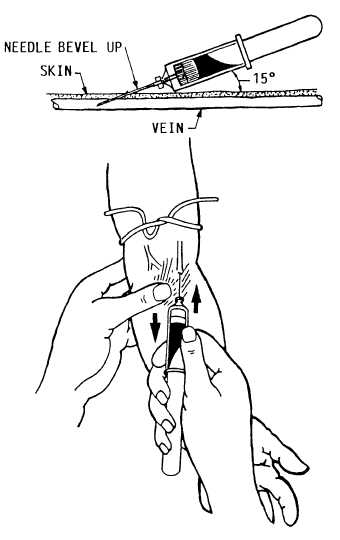above the puncture site may be applied to obtain a free flow of blood.
5. When the required blood has been obtained, apply a pad of sterile gauze and instruct the patient to apply pressure, then apply a bandage.
When dealing with infants and very small children, the heel or great toe puncture is the best method to obtain a blood specimen. It is performed in much the same way.

Figure 6-2.—Venipuncture.
VENIPUNCTURE (METHOD)
The collection of blood from a vein is called venipuncture. For the convenience of technician and patient, arm veins are best for obtaining a blood sample. If arm veins cannot be used due to bandages, IV fluid therapy, thrombosed or hardened veins, etc., consult your supervisor for instructions on the use of hand or foot veins. DO NOT DRAW BLOOD FROM AN ARM WITH IV FLUID RUNNING INTO IT. CHOOSE ANOTHER SITE, THE FLUID ALTERS TEST RESULTS.
Equipment required
Position the patient so that the vein is easily accessible and you are able to perform the venipuncture in a comfortable position. Always have the patient either lying in bed or sitting in a chair with the arm propped up. NEVER PERFORM A VENIPUNCTURE WITH THE PATIENT STANDING UP, AND USE CAUTION TO ENSURE THE PATIENT DOES NOT FALL FORWARD FROM HIS OR HER SEAT.
Procedure
1. Wash hands.
2. Assemble equipment.
3. Explain the procedure to the patient.
4. Apply the tourniquet around the arm approximately 2 to 3 inches above the anticubital fossa with enough tension so that the VEIN is compressed but not the ARTERY. A sphymomanometer may be used instead of a tourniquet if a patient is difficult to draw.
5. Position the patient’s arm extended with little or no flexion at the elbow.
6. Locate a prominent vein by palpation (feeling). If the vein is difficult to find, it may be made more prominent by massaging the arm with an upward motion to force blood into the vein.
7. Cleanse the puncture site with a 70 percent alcohol pad or Povidone-iodine solution and allow to dry.
